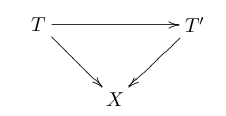The Sullivan conjecture on maps from classifying spaces originated in Sullivan’s work on localizations and completions in topology, which together with étale homotopy theory led him to a proof of the classical Adams conjecture. The purpose of this post is to briefly explain the conjecture; in the next post I’ll discuss Sullivan’s proof.
1. Vector bundles and spherical fibrations
Let be a finite CW complex. Given a real
-dimensional vector bundle
, one can form the associated spherical fibration
with fiber
by endowing
with a euclidean metric and taking the vectors of length one in each fiber. The Adams conjecture is a criterion on when the sphere bundles associated to vector bundles are fiber homotopy trivial. It will be stated in terms of the following definition:
Definition 1 Let
be the quotient of the Grothendieck group
of vector bundles on
by the relation that
if
have fiber homotopy equivalent sphere bundles (or rather, the group generated by it).
Observe that if and
have fiber homotopy equivalent sphere bundles, then so do
; for example, this is because the sphere bundle of
is the fiberwise join of that of
and
. It is sometimes more convenient to work with pointed spherical fibrations instead: that is, to take the fiberwise one-point compactification
of a vector bundle
rather than the sphere bundle. In this case, the fiberwise join is replaced with the fiberwise smash product; we have
where denotes a fiberwise smash product.
One reason is that this is of interest is that the group of vector bundles on a space
is often very computable, thanks to Bott periodicity which identifies the
-groups of a point. The set of spherical fibrations is much harder to describe: to describe the spherical fibrations over
essentially amounts to computing a bunch of homotopy groups of spheres.
2. An abstract reformulation
It is possible to phrase the above more abstractly. Given a vector bundle , we can think of it as a “family of vector spaces”
parametrized by the points
. One-point compactifying at each level, we get a family of pointed spheres
. Taking suspension spectra, we get a family of spectra
. We can think of this as the “stable spherical fibration” associated to the vector bundle
: a family of sphere spectra parametrized by
. A way of making this precise is the Grothendieck construction, which identifies spaces fibered over
with functors from
(considered as an
-category) into the
-category of spaces.
More explicitly, we have a map of group-like topological monoids
from to the monoid of self-equivalences of
(preserving the basepoint). The classifying space
classifies
-bundles (i.e., vector bundles). The classifying space
classifies pointed
-fibrations. And the unstable
-homomorphism is the map
Taking the colimit, we get a map
from to the classifying space of the monoid of self-equivalences of the sphere spectrum
. The space
classifies “families of sphere spectra.” This is the stable
-homomorphism, and the group
is the image of
in
.
In fact, it is an infinite loop map, as it arises as the group-completion of the map of symmetric monoidal topological categories
which sends a vector space to its one-point compactification.
The spectrum can be thought of the “spectrum of units” of the sphere spectrum (see e.g. this paper of Ando-Blumberg-Gepner-Hopkins-Rezk for a modern exposition); as an infinite loop space, it is the union of the components
of the infinite loop space
of
. The (infinite loop) group law comes from multiplication in the sphere spectrum, though. In particular, we have
We get a map
which is the classical formulation of the -homomorphism.
3. Dold’s theorem
In order to motivate the Adams conjecture, we’ll need to give some examples of vector bundles which are not equivalent but have equivalent spherical fibrations. A criterion of Dold will be useful here.
Example 1 (Dold) Let classify (pointed) stable spherical fibrations
over
(which can be thought of as parametrized spectra or spherical fibrations of large dimension). Suppose that there is a fiberwise map
which is of degree on each fiber. In other words, the parametrized spectra become equivalent after fiberwise inversion of
. There is a space (in fact, an infinite loop space)
which classifies parametrized
‘s in a similar manner.
In particular, the maps
are homotopic. But the map
can be identified with a covering map. It follows that the maps are homotopic, or that (since
is a finite complex!)
That is, after “multiplying by ” (i.e., by taking fiberwise smash products
times) the spherical fibrations associated to
become fiber homotopy equivalent.
Example 2 (Adams) In general, it is possible for non-equivalent vector bundles to have equivalent spherical fibrations. Let be a complex line bundle (equivalently, an oriented real
-dimensional bundle). Consider the spherical fibrations (
-bundles) associated to
and
. There is a map
which is of degree on each fiber. As a result, the element
maps to zero in .
4. The Adams conjecture
One notes now that can also be described as
, where
is the Adams conjecture. Adams conjectured that this natural generalization worked for any vector bundle:
Adams conjecture: Let be a real vector bundle on
. Then, for
,
maps to zero in
.
In other words, the stable spherical fibration associated to is fiber homotopy trivial. In more abstract language, we can state:
Adams conjecture (restated): The map
is nullhomotopic.
For simplicitly, let’s see what this implies when is replaced by the complex version
. We have
and if is a generator, then
. In particular, it follows that
for each . Taking the least common multiple over all
, Adams observed that this conjecture enabled one to thus bound above the image of the
-homomorphism.

November 18, 2013 at 12:50 am
Nice notes! Spotted two trivial typos: after “there is a map” there’s a spurious closing parenthesis in the exponent and: first line of 4: “Adams conjecture” -> “Adams operation”